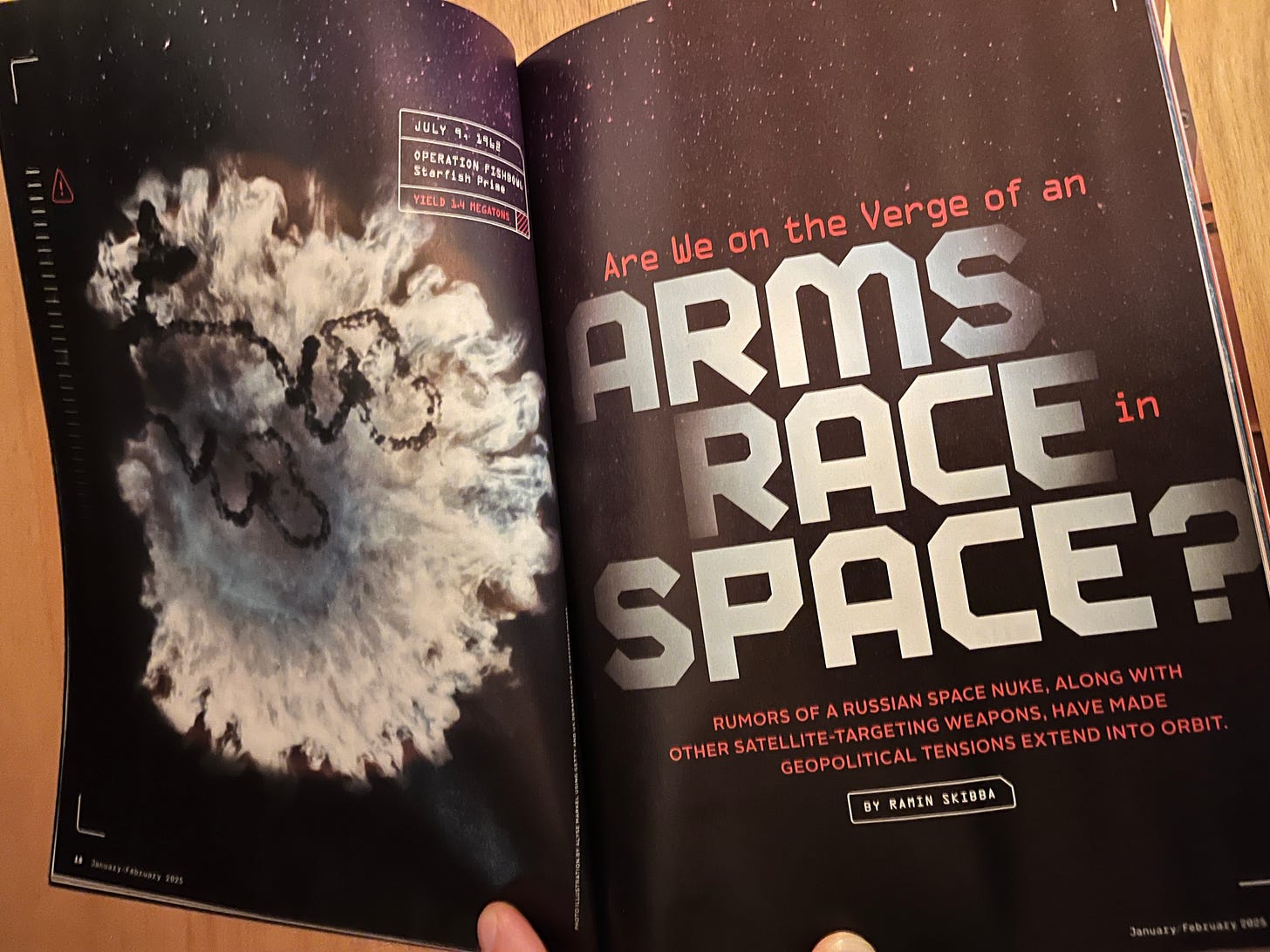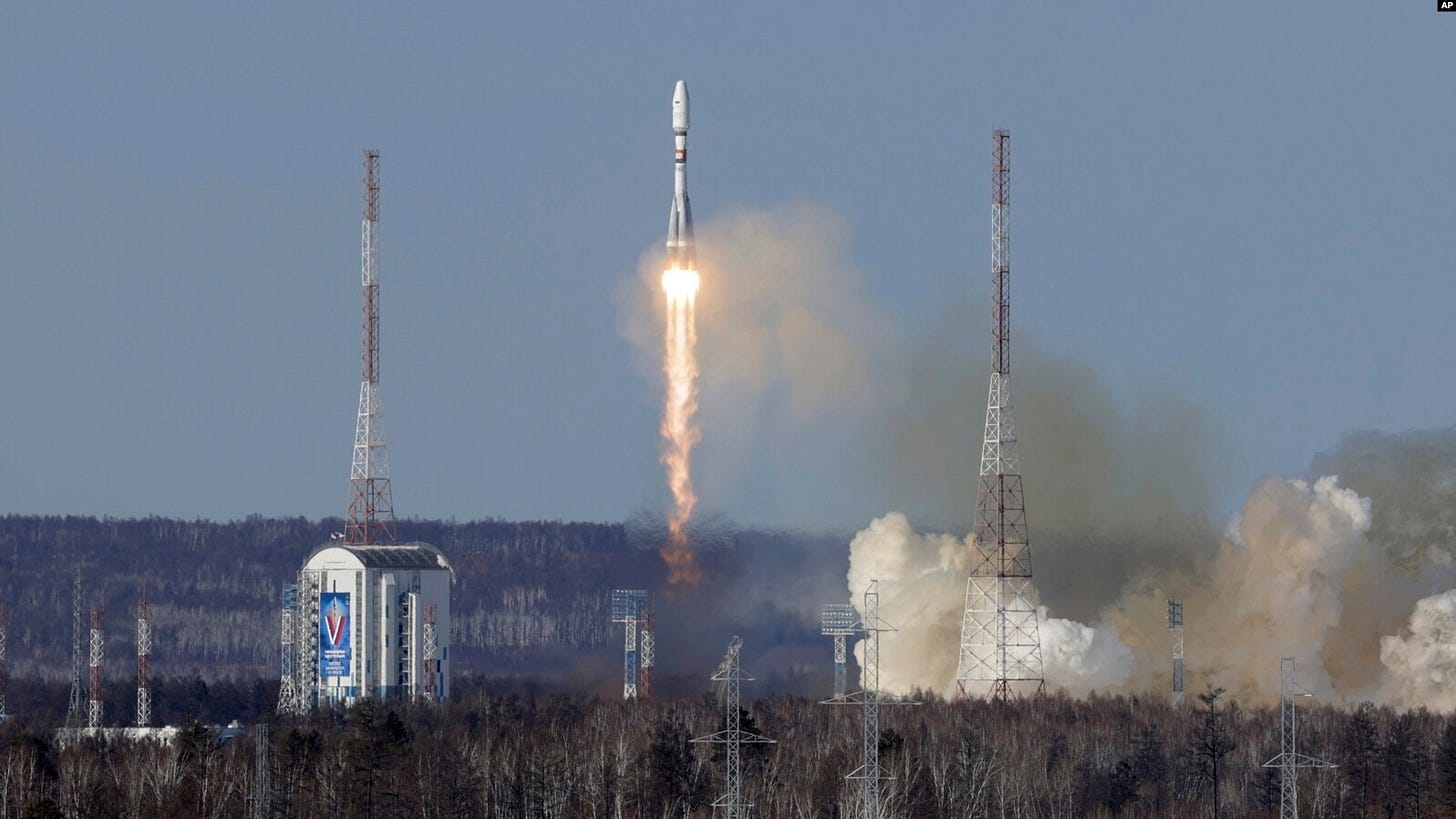On the brink of an arms race in space, and other stories
Welcome to Ramin’s Space, the newsletter from science writer and editor Ramin Skibba. You can read more about the newsletter here. If you like it, please consider subscribing and sharing this post.
Are We on the Verge of an Arms Race in Space?
I’m proud to share my new feature in the January/February issue of Popular Mechanics magazine. I take on the dangerous new terrain of space weaponry, beginning with last year’s rumors of a Russian nuclear space weapon program. The US and USSR both previously tested such space nukes in the atmosphere in the early 1960s—at the same time as Cuban Missile Crisis, when the Soviets placed nukes in Cuba after the US did the same in Turkey. But nukes in space were soon made illegal, and I doubt Russia would consider such a weapon, which would threaten so many of its own critical spacecraft as well.
Despite the whiplash of changes of administrations in the US, space policy and nuclear policy don’t actually change that much every four or eight years. Trump’s proposed “Iron Dome for America” sounds like a shift, as he’s proposing space-based interceptors to shoot down missiles, except that it’s not that different than President Reagan’s Star Wars boondoggle in the 1980s. Even if such a massive weapon system were a good idea ethically or geopolitically—and it isn’t—it would be a huge waste of money and I’m skeptical it would even work.
Defense contractors that profit handsomely from missile defense investment, especially Lockheed and Northrop Grumman, are salivating over this move, but I don’t really expect that executive order to change much. Sort of like how the rise of DeepSeek doesn’t change the power dynamics in the US tech world all that much, or at least not yet. On that note, it’s interesting that China was able to rise to the level of the US on space military capabilities while spending less money, sort of similar to the billions shoveled into OpenAI’s and Anthropic’s models, which turn out to be no better than the Chinese alternative. DeepSeek is not just less expensive but less energy intensive too, but it’s also mostly open-source, very different than space military tech.
And now, as this Popular Mechanics issue went to press, Trump’s people came to power. He, along with unelected Elon Musk and his acolytes, are threatening workers, resources, and critical data at NASA, NOAA, the National Science Foundation, health agencies, and other agencies. Trump, Musk, and their allies are creating tumult and mayhem throughout these agencies, and at the same time, Trump and Secretary of State Rubio have no qualms about escalating tensions with China and with traditional US allies. Chaos at home and abroad.
In December 2015, Musk was invited to speak in Paris just before the historic climate summit, and then the US’s flagship Earth and climate science association, the American Geophysical Union (AGU), brought Musk to speak at its big meeting in San Francisco, packed with 30,000 scientists and journalists (including me). I thought that high-profile invitation was a bad idea, but that was back when American libertarians and liberals both loved him. Yes, some billionaires are better than others, but it should be obvious by now that it’s dangerous to idolize them and give any of them unaccountable power. Those annual AGU conferences always include presentations of a breadth of cutting-edge research and programs associated with NOAA, NASA, the NSF, and other institutions that Musk’s now attempting to throttle and gut for his own ideological agenda and financial gain. The US has arguably always been an oligarchy, but now the masks are off. At least now we’re starting to see some organized resistance against Trump and the Nazi-saluting Musk. But #resistance isn’t enough; people have to organize.
For our part, my colleagues and I at the National Association of Science Writers just published a statement today, condemning the Trump administration’s halt to external communications and removal of crucial information at the NIH, CDC, and FDA, and our health journalist counterparts have published an open letter in the same vein. And while Trump’s Education Department falsely says book bans are a ‘hoax,’ my colleagues at the Authors Guild have joined publishers in a federal lawsuit against library book bans in Idaho and other states. There will be more to come.
In other writing…
Do Our Dogs Have Something to Tell the World? by my former WIRED colleague Camille Bromley in NYT magazine, with some interesting discussions of animal communication
Iraq’s Ancient Marshes Are Running Out of Time, by Jaclynn Ashly in Jacobin magazine
Inventing the Commons: On Alternative Technologies, an essay by Yásnaya Elena Gil in the new issue of Guernica magazine. I also recommend the poems published there by Najwan Darwish.
A Good Company, by Justin Nobel in Harper’s magazine. It’s a wide-ranging essay about book publishing, fracking, and oil and gas waste.
What Lies Beneath, a feature about Lake Tahoe’s invasive species, by Sonya Bennett-Brandt in Bay Nature
‘Plastics are awesome’: Inside the Energy Department’s partnership with the plastics industry, some accountability journalism by Joseph Winters & Emily Sanders in Grist magazine. Just wanted to share it because it fits with my anti-plastic agenda.
What I’m reading: The Message, by Ta-Nehisi Coates. It’s eloquently written, and so far (I’m halfway through), it reads like a lengthy essay meditating on race, politics, and xenophobia, while reflecting on the US’s racist history and Israel’s apartheid regime. The book shouldn’t be considered so controversial, but some people prefer unsettling truths to remain unsaid.
Looking back: Nine years ago, I wrote a few articles for the Monterey Herald, a small central Californian newspaper, including this one about contentious local fracking debates. Now a former fracking executive is running the vast US Energy Department, thanks to a bipartisan vote on Monday. Too few people want to keep fossil fuels in the ground.
More about me: I’m a science writer, editor, and journalist based in the Bay Area. I was WIRED magazine’s space writer until December 2023, and before that I worked as a freelance writer and an astrophysicist. You can find me at my website, raminskibba.net, and on Twitter and Bluesky. I’m also former president of the San Diego Science Writers Association (SANDSWA) and on the board of the National Association of Science Writers (NASW), though the opinions I express are mine alone. If someone has forwarded this email to you, you’re welcome to subscribe too.




